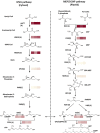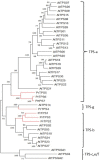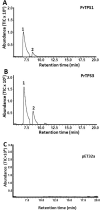Chemical profile and analysis of biosynthetic pathways and genes of volatile terpenes in Pityopsis ruthii, a rare and endangered flowering plant
- PMID: 37352235
- PMCID: PMC10289357
- DOI: 10.1371/journal.pone.0287524
Chemical profile and analysis of biosynthetic pathways and genes of volatile terpenes in Pityopsis ruthii, a rare and endangered flowering plant
Abstract
It is critical to gather biological information about rare and endangered plants to incorporate into conservation efforts. The secondary metabolism of Pityopsis ruthii, an endangered flowering plant that only occurs along limited sections of two rivers (Ocoee and Hiwassee) in Tennessee, USA was studied. Our long-term goal is to understand the mechanisms behind P. ruthii's adaptation to restricted areas in Tennessee. Here, we profiled the secondary metabolites, specifically in flowers, with a focus on terpenes, aiming to uncover the genomic and molecular basis of terpene biosynthesis in P. ruthii flowers using transcriptomic and biochemical approaches. By comparative profiling of the nonpolar portion of metabolites from various tissues, P. ruthii flowers were rich in terpenes, which included 4 monoterpenes and 10 sesquiterpenes. These terpenes were emitted from flowers as volatiles with monoterpenes and sesquiterpenes accounting for almost 68% and 32% of total emission of terpenes, respectively. These findings suggested that floral terpenes play important roles for the biology and adaptation of P. ruthii to its limited range. To investigate the biosynthesis of floral terpenes, transcriptome data for flowers were produced and analyzed. Genes involved in the terpene biosynthetic pathway were identified and their relative expressions determined. Using this approach, 67 putative terpene synthase (TPS) contigs were detected. TPSs in general are critical for terpene biosynthesis. Seven full-length TPS genes encoding putative monoterpene and sesquiterpene synthases were cloned and functionally characterized. Three catalyzed the biosynthesis of sesquiterpenes and four catalyzed the biosynthesis of monoterpenes. In conclusion, P. ruthii plants employ multiple TPS genes for the biosynthesis of a mixture of floral monoterpenes and sesquiterpenes, which probably play roles in chemical defense and attracting insect pollinators alike.
Copyright: This is an open access article, free of all copyright, and may be freely reproduced, distributed, transmitted, modified, built upon, or otherwise used by anyone for any lawful purpose. The work is made available under the Creative Commons CC0 public domain dedication.
Conflict of interest statement
The authors have declared that no competing interests exist.
Figures






Similar articles
-
Functional genomics reveals that a compact terpene synthase gene family can account for terpene volatile production in apple.Plant Physiol. 2013 Feb;161(2):787-804. doi: 10.1104/pp.112.208249. Epub 2012 Dec 19. Plant Physiol. 2013. PMID: 23256150 Free PMC article.
-
Terpene synthases of oregano (Origanum vulgare L.) and their roles in the pathway and regulation of terpene biosynthesis.Plant Mol Biol. 2010 Aug;73(6):587-603. doi: 10.1007/s11103-010-9636-1. Epub 2010 Apr 25. Plant Mol Biol. 2010. PMID: 20419468
-
Functional Characterization of Terpene Synthases Accounting for the Volatilized-Terpene Heterogeneity in Lathyrus odoratus Cultivar Flowers.Plant Cell Physiol. 2020 Oct 1;61(10):1733-1749. doi: 10.1093/pcp/pcaa100. Plant Cell Physiol. 2020. PMID: 32726442
-
Understanding the Constitutive and Induced Biosynthesis of Mono- and Sesquiterpenes in Grapes (Vitis vinifera): A Key to Unlocking the Biochemical Secrets of Unique Grape Aroma Profiles.J Agric Food Chem. 2015 Dec 16;63(49):10591-603. doi: 10.1021/acs.jafc.5b04398. Epub 2015 Dec 3. J Agric Food Chem. 2015. PMID: 26592256 Review.
-
The family of terpene synthases in plants: a mid-size family of genes for specialized metabolism that is highly diversified throughout the kingdom.Plant J. 2011 Apr;66(1):212-29. doi: 10.1111/j.1365-313X.2011.04520.x. Plant J. 2011. PMID: 21443633 Review.
References
-
- Congress U. Endangered species act. US Code. 1973;16:1534–44.
-
- New York and Oxford: efloras.org; 2006 [cited 2023 2023-03-06].
-
- Moore PA, Wadl PA, Skinner JA, Trigiano RN, Bernard EC. Current knowledge, threats, and future efforts to sustain populations of Pityopsis ruthii (Asteraceae), an endangered southern Appalachian species. The Journal of the Torrey Botanical Society. 2016;143(2):117–34.
-
- White AJ. An autecological study of the endangered species, Heterotheca ruthii (Small) Harms: University of Tennessee, Knoxville; 1977.
-
- Ruth’s Golden Aster (Pityopsis ruthii). 5-year review: Summary and evaluation: U.S. Fish and Wildlife Service; 2018. [cited 2023 2023-03-06]. Available from: https://ecos.fws.gov/docs/five_year_review/doc5953.pdf.
Publication types
MeSH terms
Substances
LinkOut - more resources
Full Text Sources

